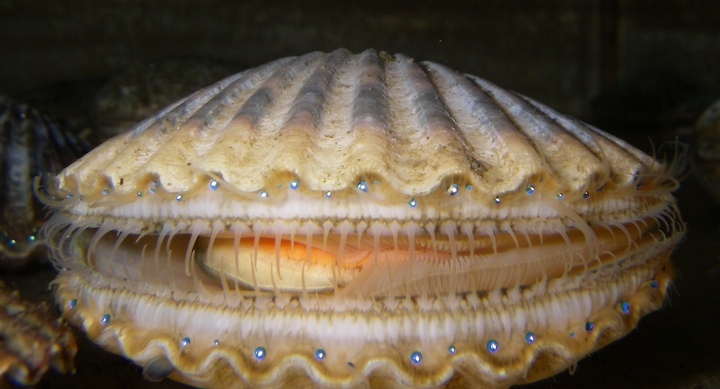What Are Scallops? A Comprehensive Guide
Scallops are a type of shellfish that are highly prized for their delicate flavor and tender texture. These bivalve mollusks are found in oceans around the world and have been a staple in many cuisines for centuries. In this comprehensive guide, we’ll explore the fascinating world of scallops, including their anatomy, habitat, culinary uses, and more.
Anatomy and Habitat
Scallops belong to the family Pectinidae and are characterized by their distinctive fan-shaped shells. These shells are typically made up of two valves, one flat and one slightly cupped. Inside the shell, scallops have a single adductor muscle, which is the part that is typically eaten.Scallops can be found in a variety of habitats, from shallow coastal waters to deep ocean floors. They prefer areas with strong currents and sandy or rocky bottoms, which provide them with the necessary food and protection. Some species of scallops, such as the bay scallop, live in estuaries and bays, while others, like the sea scallop, are found in deeper waters.
Culinary Uses
Scallops are highly prized in many cuisines around the world, particularly in seafood-centric regions like New England, the Pacific Northwest, and Japan. They can be prepared in a variety of ways, including:
- Seared: Scallops are often seared in a hot pan with butter or oil, resulting in a crispy exterior and tender interior.
- Baked: Scallops can be baked with breadcrumbs, cheese, or other toppings for a delicious and easy-to-prepare dish.
- Grilled: Scallops are perfect for grilling, as they cook quickly and take on a lovely smoky flavor.
- Raw: Some varieties of scallops, such as the Japanese hotate, are enjoyed raw in sashimi or ceviche preparations.
Scallops are also a popular ingredient in soups, stews, and pasta dishes, adding a delicate sweetness and tender texture to the overall dish.
Nutritional Value
Scallops are not only delicious but also highly nutritious. They are an excellent source of protein, with a 3.5-ounce serving containing around 20 grams of protein. Scallops are also low in fat and calories, making them a healthy choice for those watching their weight.In addition to protein, scallops are a good source of several essential vitamins and minerals, including:
- Vitamin B12: Scallops are an excellent source of vitamin B12, which is important for red blood cell formation and neurological function.
- Selenium: This mineral acts as an antioxidant in the body and is important for thyroid function and immune health.
- Magnesium: Scallops contain a significant amount of magnesium, which is essential for muscle and nerve function, as well as energy production.
Frequently Asked Questions (FAQ)
1. What is the difference between bay scallops and sea scallops?
The main difference between bay scallops and sea scallops is their size. Bay scallops are smaller, typically measuring around 1/2 to 3/4 inch in diameter, while sea scallops are larger, ranging from 1 to 2 inches in diameter. Bay scallops are often sweeter in flavor compared to sea scallops.
2. How do I know if scallops are fresh?
Fresh scallops should have a sweet, briny aroma and a firm, slightly translucent texture. Avoid scallops that have a strong fishy odor or are discolored or dried out.
3. Can scallops be frozen?
Yes, scallops can be frozen for later use. To freeze scallops, rinse them under cold water, pat them dry, and place them in a single layer on a baking sheet. Once frozen, transfer the scallops to an airtight container or freezer bag. Properly frozen scallops can last for up to 3 months.
4. How do I cook scallops?
Scallops are best cooked quickly over high heat to prevent them from becoming tough and rubbery. For seared scallops, pat them dry and season with salt and pepper. Heat a tablespoon of oil or butter in a skillet over high heat and sear the scallops for 2-3 minutes per side, until they develop a golden-brown crust.
5. Are scallops sustainable?
Many scallop fisheries around the world are well-managed and considered sustainable. However, some areas may have overfishing or bycatch concerns. When purchasing scallops, look for those that are certified by organizations like the Marine Stewardship Council (MSC) or Aquaculture Stewardship Council (ASC) to ensure they come from sustainable sources.
Table with Wikipedia or .gov Link
| Metric | Value |
|---|---|
| Protein in a 3.5-ounce serving | 20 grams |
| Vitamin B12 content | Excellent source |
| Selenium content | Good source |
| Magnesium content | Good source |
| Typical size of bay scallops | 1/2 to 3/4 inch diameter |
| Typical size of sea scallops | 1 to 2 inches diameter |
| Maximum frozen storage time | 3 months |
For more information on scallops and their nutritional value, visit the USDA FoodData Central database.In conclusion, scallops are a delicious and nutritious seafood option that can be prepared in a variety of ways. Whether you prefer them seared, baked, or raw, scallops are sure to impress with their sweet flavor and tender texture. By understanding the different types of scallops and how to select and prepare them, you can enjoy this delightful shellfish at its best.



